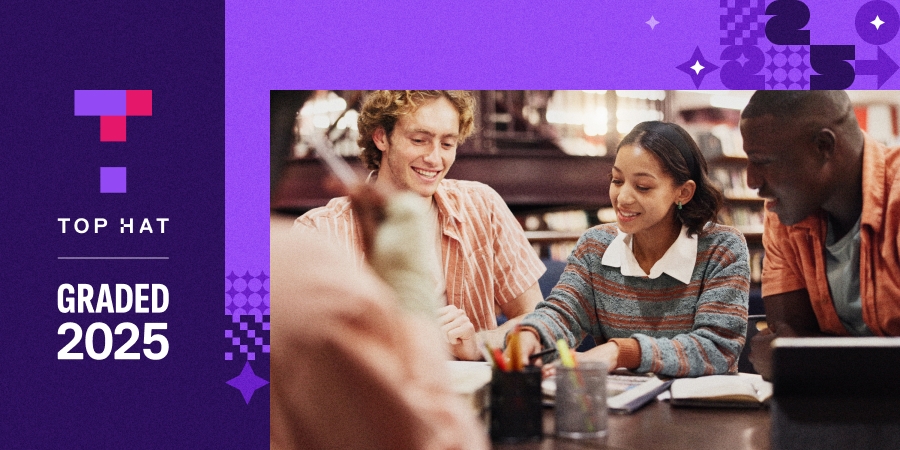Gone are the days of arriving at a bookstore and walking out with a stack of textbooks. ‘Add to cart’ has become an increasingly popular—and inescapable—option for courseware shopping. Prior to 2020, the education system had already started favoring online lesson plans and course readings, much to the delight of digital natives. But COVID-19 has brought with it new health and safety concerns that impact traditional books. Plus delays in print publishing and financial hardships are an increasingly common reality. Here are three reasons why digital courseware is the ideal solution for today’s students—even after in-person classes resume.
Top Hat’s online bookstore offers thousands of affordable interactive textbooks. Click here to explore.
Digital textbooks are made to withstand health and safety challenges
With a pandemic that shows no signs of slowing down, some colleges like Roger Williams University are taking precautionary measures.1 The campus’ library quarantines print materials for 72 hours before returning the books to their shelves. For students who rely on libraries for textbook access, this delay is far from ideal. The current health crisis may cause both health and accessibility concerns for many nationwide, but digital books are a safer and more equitable solution for every learner.
In Top Hat’s recent survey of over 3,400 post-secondary students, 31 percent of learners stated that most of their assigned readings came in the form of PDFs. Another 26 percent of students stated that most of their assigned courseware was in the form of digital interactive textbooks—versus 15 percent for traditional textbooks. It’s a growing contingent of people using virtual courseware, and that’s a good thing. Digital books give learners access anytime, anywhere, without having to make a trip to the campus library or bookstore. Plus, international students can appreciate being able to access and download readings on their digital devices.
The print textbook market is taking (another) hit
Some students may prefer physical textbooks for their tactile nature. However, the print publishing market has been dealt its share of challenges this year due to the pandemic. A number of printers have been forced to shut down their plants and cease operations.2 Textbook revenue from university presses saw a decline of over 21 percent in March 2020 alone.3 Printing companies such as Quad are now up for sale, after three plant shutdowns and the company not being able to recover from a significant stock price drop in March.
The average print textbook goes out of date every three years4—but e-textbooks guarantee students permanent, up-to-date access to course content. The four largest textbook publishers—McGraw Hill, Wiley, Cengage and Pearson—along with platforms like Amazon, thrive on being able to release new editions. But with COVID-19, digital courseware, including open educational resources (OER), allow for free use and redistribution. Plus, educators can customize some e-books to meet their course needs without having to assign a new book to their students.
Students are able to save big by switching to digital learning experiences
Research shows that Americans owe more than $1.5 trillion in student loan debt. Even more worrying, four-year degree holders take an average of 19.7 years to pay off their loans.5 Bill and Melinda Gates’ annual letter from 2019 paints the standalone college textbook as “a thing of the past.”6 Data from this year support the Gates Foundation’s stance on traditional school textbooks: on average, students in higher education spent seven percent less on course materials this fall compared to last year.7 Amid plenty of non-academic concerns, paying hundreds for a book that students will likely never look at after the course finishes isn’t top of mind.
Daniel Maxwell, a lecturer in the criminal justice department at the University of New Haven, found students were struggling with the $200 price tag that came with his course textbook. “Students will do anything to get out of buying them and if they do buy them they won’t use 95 percent of the book,” he says. Maxwell abandoned his print book in favor of Top Hat’s interactive textbook and found that the benefits were two-fold. Not only did students perform seven percent better on their quizzes after using Top Hat, they also saved $150 per semester.
Bring your dream textbook to life using Top Hat’s authoring tools. Learn more here.
References
- McKenzie, L. (2020, October 13). Textbooks in Short Supply Amid COVID Quarantines. Inside Higher Ed. https://www.insidehighered.com/news/2020/10/13/covid-19-forces-college-libraries-quarantine-textbooks-hitting-low-income-students
- Gouty, M. Unexpected Effects of the Pandemic on the Publishing Industry. Medium. https://medium.com/the-innovation/unexpected-effects-of-the-pandemic-on-the-publishing-industry-b0cf5d9e3f54
- Alter, A. (2020, May 19). Coronavirus Shutdowns Weigh on Book Sales. The New York Times. https://www.nytimes.com/2020/05/19/books/coronavirus-book-sales-march-2020.html
- Dhami, H. (2019, July 10). The Average Print Textbook Goes Out of Date Every 3 Years. Top Hat. https://tophat.com/blog/print-textbook-editions/
- Student Loan Debt. Nitro College. https://www.nitrocollege.com/research/average-student-loan-debt
- Gates, B., & Gates, M. Our 2019 Annual Letter. We didn’t see this coming. GatesNotes. https://www.gatesnotes.com/2019-Annual-Letter
- Hill, P. (2020, Nov. 8). Fall 2020 Updates: What do college students actually spend on course materials. Phil on EdTech. https://philonedtech.com/fall-2020-updates-what-do-college-students-actually-spend-on-course-materials/


